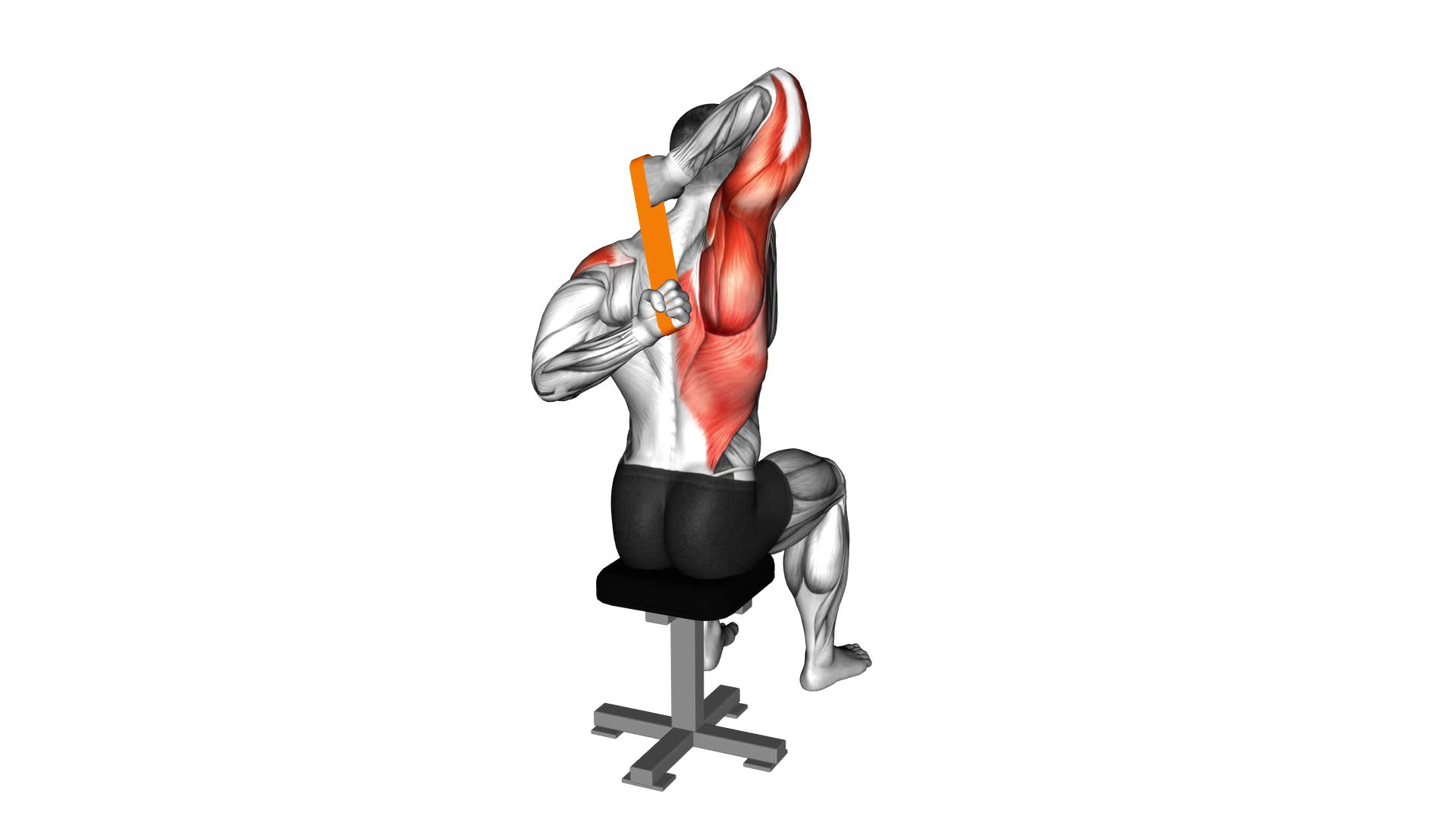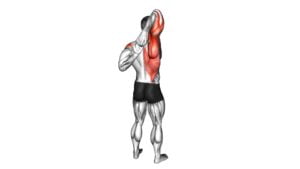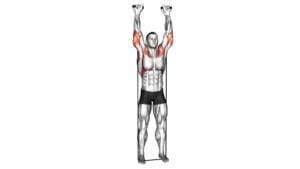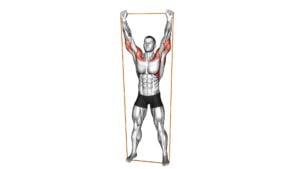Resistance Band Shoulder Stretch Behind the Back – Video Exercise Guide & Tips

Looking to improve your shoulder flexibility and range of motion? Check out this video exercise guide and tips for the resistance band shoulder stretch behind the back.
Watch This Exercise Video
With just a resistance band and a few minutes of your time, you can target your shoulder muscles and increase mobility. Whether you're a beginner or a seasoned fitness enthusiast, this stretch is a great addition to your workout routine.
Get ready to feel the burn and reap the benefits of this effective exercise.
Key Takeaways
- Improved flexibility and shoulder mobility
- Alleviate tension and tightness in shoulders and upper back
- Increased shoulder mobility
- Enhanced upper body strength
Benefits of Resistance Band Shoulder Stretch
You can experience several benefits from incorporating resistance band shoulder stretches into your fitness routine. These stretches can greatly improve flexibility and shoulder mobility, allowing you to move more freely and comfortably in your daily activities and exercise routines.
By using resistance bands, you're able to target specific muscle groups in your shoulders and upper back, helping to increase their range of motion and flexibility. This can be especially beneficial for individuals who've tight or stiff shoulders, as the resistance bands provide gentle tension that helps to elongate and stretch the muscles.
Not only can resistance band shoulder stretches improve your overall flexibility, but they can also help to alleviate tension and tightness in the shoulders and upper back. This can be particularly helpful for individuals who spend long periods of time sitting or working at a desk, as it can help to counteract the effects of poor posture.
Incorporating resistance band shoulder stretches into your fitness routine is a simple and effective way to improve your shoulder mobility and overall flexibility.
Now that you understand the benefits of resistance band shoulder stretches, let's discuss the equipment needed for this exercise.
Equipment Needed for the Exercise
To perform the resistance band shoulder stretch behind the back exercise, you'll need a resistance band. This exercise equipment is essential for providing the necessary resistance to stretch and strengthen your shoulder muscles effectively. Resistance bands are affordable, portable, and versatile, making them a popular choice for home workouts and stretching techniques.
When choosing a resistance band for this exercise, opt for one that offers enough resistance to challenge your shoulder muscles without causing strain or discomfort. There are different levels of resistance bands available, so select the one that matches your fitness level and goals.
Make sure the resistance band is in good condition with no signs of wear or tear before starting the exercise. It should be long enough to comfortably wrap around your hands and allow for a full range of motion.
In addition to the resistance band, you may also benefit from using a yoga mat or towel to provide cushioning and support during the exercise. This will help prevent any discomfort or strain on your knees or back.
Proper Form and Technique
To ensure proper form and technique, it's important to maintain a strong and stable posture throughout the resistance band shoulder stretch behind the back exercise. This exercise primarily targets the shoulder and upper back muscles, helping to improve flexibility and range of motion in that area.
To begin the exercise, stand with your feet shoulder-width apart and hold the resistance band with both hands, palms facing up. Keep your back straight and engage your core muscles to stabilize your body. Avoid rounding your shoulders or leaning forward during the stretch, as this can compromise the effectiveness of the exercise and increase the risk of injury.
To deepen the stretch, gently pull the resistance band downwards, away from your body, while keeping your arms straight. It's important to remember that this exercise shouldn't cause any pain or discomfort. Common mistakes to avoid include using too much tension in the band, which can strain the muscles, and rushing through the movements.
Variations and Modifications
There are several ways to modify and vary the resistance band shoulder stretch behind the back exercise. Here are some alternative stretches and common mistakes to be aware of:
- Alternative Stretches:
- Overhead Shoulder Stretch: Stand tall, reach both arms overhead, and interlace your fingers. Gently push your hands up towards the ceiling while keeping your shoulders down.
- Cross-Body Shoulder Stretch: Extend one arm across your chest and use your other hand to gently pull your arm towards your body. Hold for a few seconds and then switch sides.
- Common Mistakes:
- Using too much tension: It's important to choose a resistance band with the appropriate level of tension for your strength and flexibility. Start with a lighter band and gradually increase the tension as you progress.
- Hunching the shoulders: Keep your shoulders relaxed and down, away from your ears, throughout the exercise. Avoid hunching or rounding your back.
- Holding your breath: Remember to breathe deeply and naturally during the stretch. Inhale as you prepare, and exhale as you stretch.
Tips for a Safe and Effective Stretch
To ensure a safe and effective stretch, it's important to follow these tips.
First, avoid common mistakes such as overstretching or forcing the movement. Instead, listen to your body and stop if you feel any pain or discomfort.
It's also crucial to maintain proper form throughout the stretch. Keep your shoulders relaxed and down, and engage your core to avoid straining your back.
Additionally, make sure to breathe deeply and fully during the stretch to help relax your muscles and increase flexibility.
In terms of frequency, it's recommended to perform this stretch two to three times a week. This allows your muscles to adapt and improve over time without overdoing it.
However, if you have any pre-existing injuries or conditions, it's best to consult with a healthcare professional before starting any new stretching routine. They can provide personalized advice and guidance based on your specific needs.
Incorporating Resistance Band Shoulder Stretch Into Your Workout Routine
Include the resistance band shoulder stretch behind the back as part of your regular workout routine. This stretch is a great way to improve shoulder mobility and flexibility. By incorporating this exercise into your stretching routine, you can reap the benefits of increased range of motion and reduced risk of injury.
Here are three reasons why you should include the resistance band shoulder stretch behind the back in your workout routine:
- Improved shoulder mobility: This stretch targets the muscles and tendons in your shoulders, helping to increase their flexibility and range of motion. By regularly performing this exercise, you can improve your overall shoulder mobility, making it easier to perform everyday activities and other exercises.
- Enhanced upper body strength: The resistance band adds an extra challenge to the shoulder stretch, helping to strengthen the muscles in your upper body. This can improve your overall strength and stability, making you less prone to injuries.
- Injury prevention: By stretching and strengthening the muscles in your shoulders, you can reduce the risk of injuries such as shoulder impingement or rotator cuff tears. Incorporating the resistance band shoulder stretch behind the back into your routine can help keep your shoulders healthy and pain-free.
Including the resistance band shoulder stretch behind the back in your workout routine is a simple and effective way to improve your shoulder mobility and reduce the risk of injuries. Make sure to consult with a fitness professional to ensure proper form and technique when performing this exercise.
Frequently Asked Questions
How Long Should I Hold the Resistance Band Shoulder Stretch Behind the Back?
To get the most out of the resistance band shoulder stretch behind the back, it's important to know how long to hold it. Proper technique is key for this exercise.
While the specific duration may vary depending on your fitness level and flexibility, a general guideline is to hold the stretch for about 20-30 seconds. This allows your muscles to lengthen and improve their flexibility.
The benefits of resistance band stretches include increased shoulder mobility and reduced risk of injury.
Can I Use a Towel or Belt Instead of a Resistance Band for This Stretch?
Yes, you can use a towel or belt as an alternative option for the resistance band in this stretch. However, it's important to note that using a resistance band offers additional benefits.
The resistance band provides adjustable tension, allowing you to gradually increase the stretch over time. It also helps to engage the muscles more effectively.
Should I Feel Any Discomfort or Pain During the Stretch?
During the resistance band shoulder stretch, you shouldn't feel any discomfort or pain. It's important to maintain proper form to prevent injury. If you experience any discomfort, adjust the tension of the band or try a lighter resistance.
Beginners can modify the stretch by using a towel or belt instead of a resistance band. Remember to listen to your body and stop if you feel any pain.
Proper form and modifications are key to a safe and effective shoulder stretch.
Can I Perform This Stretch if I Have a Shoulder Injury?
If you have a shoulder injury, it's important to modify your stretches to avoid further damage.
While the resistance band shoulder stretch behind the back may not be suitable for you, there are alternative stretches that can help alleviate discomfort and promote healing.
It's best to consult with a healthcare professional or physical therapist who can guide you in selecting the appropriate stretches for your specific shoulder injury.
Is It Necessary to Warm up Before Doing the Resistance Band Shoulder Stretch Behind the Back?
Before performing the resistance band shoulder stretch behind the back, it's important to warm up. Warming up helps increase blood flow to your muscles and prepares them for the exercise. It also reduces the risk of injury.
Conclusion
Incorporating resistance band shoulder stretches into your workout routine can provide numerous benefits. These include improved flexibility, increased range of motion, and reduced risk of shoulder injuries.
By using the proper equipment and maintaining proper form and technique, you can ensure a safe and effective stretch. Don't forget to explore variations and modifications to target different areas of your shoulders.
Make this exercise a regular part of your routine for stronger and healthier shoulders.

Author
Years ago, the spark of my life’s passion ignited in my mind the moment I stepped into the local gym for the first time. The inaugural bead of perspiration, the initial endeavor, the very first surge of endorphins, and a sense of pride that washed over me post-workout marked the beginning of my deep-seated interest in strength sports, fitness, and sports nutrition. This very curiosity blossomed rapidly into a profound fascination, propelling me to earn a Master’s degree in Physical Education from the Academy of Physical Education in Krakow, followed by a Sports Manager diploma from the Jagiellonian University. My journey of growth led me to gain more specialized qualifications, such as being a certified personal trainer with a focus on sports dietetics, a lifeguard, and an instructor for wellness and corrective gymnastics. Theoretical knowledge paired seamlessly with practical experience, reinforcing my belief that the transformation of individuals under my guidance was also a reflection of my personal growth. This belief holds true even today. Each day, I strive to push the boundaries and explore new realms. These realms gently elevate me to greater heights. The unique combination of passion for my field and the continuous quest for growth fuels my drive to break new ground.







